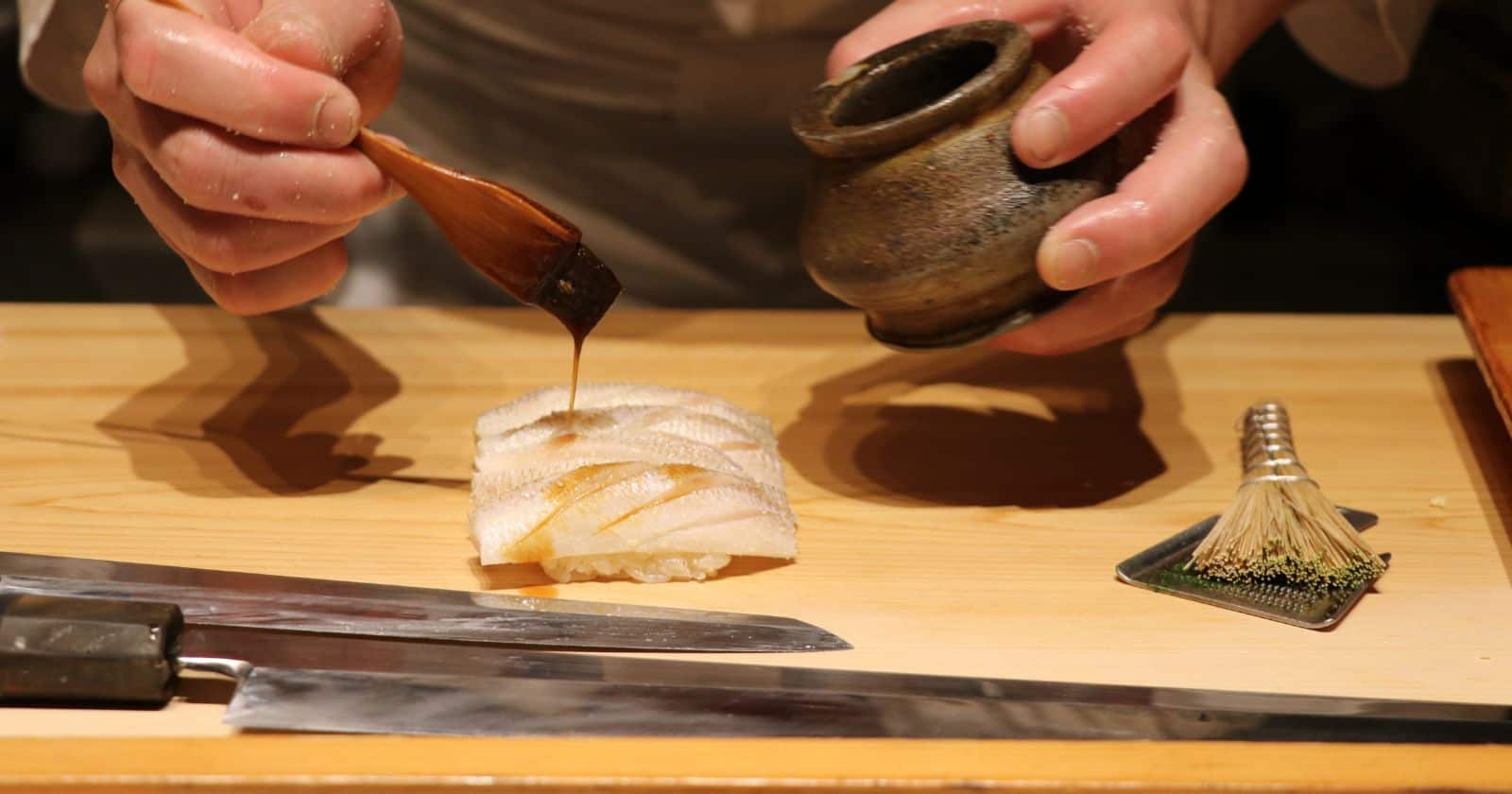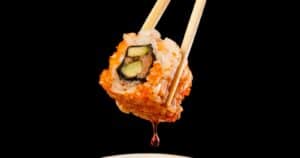Sushi may look like simple rice and fish, but the flavors can be complex and surprising. So what does sushi actually taste like? Let’s unravel the mysteries of sushi’s taste.
At its core, sushi has a mild, neutral flavor. There’s no pungent fishiness or overt saltiness. The rice is subtly sweetened by vinegar, while the fish provides an umami backbone.
The ingredients dictate the nuances. Salmon and tuna lend rich, fatty notes. Eel has a hint of smoke. Mango’s tropical tang balances the fish. And the wasabi, ginger and soy? Sharp, piquant complements.
An expert sushi chef harmonizes these elements into a symphony of flavors using balance, contrast and restraint. The result is a light, refreshing taste that dances on your palate.
But poorly made sushi can go awry, with too much vinegar, fishy notes, or plain blandness. The taste relies heavily on quality and balance.
Want the inside scoop on sushi’s true flavors? Read on to learn how the ingredients, preparation and presentation influence this iconic dish. Every delicious morsel tells a story on your tongue.
A Blank Canvas
At its core, sushi has a clean, neutral taste. High-quality sushi rice is subtly sweetened by rice vinegar. The fish provides an umami backbone without fishy or salty flavors.
This mild blank canvas allows the other ingredients’ tastes to shine through. Sushi is designed to highlight, not mask, the flavors of premium seasonal seafood and produce.
But the rice and fish aren’t completely bland. Their mellow, complementary tastes unite the bolder ingredients in each piece.
Ingredient Alchemy
Sushi’s taste journey relies heavily on the specific ingredients used. Creative pairings transform simple components into complex flavor synergy.
Fish and Seafood
Raw seafood choices provide most of sushi’s signature flavors:
- Salmon – rich, fatty, smooth
- Tuna – meaty, savory umami
- Yellowtail – buttery, mild, sweet
- Squid – chewy, salty, briny
- Eel – smoky, slick, sweet soy glaze
- Shrimp – plump, pop of sweetness
- Crab – delicate, ocean-fresh flavor
These proteins lend taste dimensions – fat, savory, salt, smoke, etc. Their freshness determines the intensity and balance.
Produce Pops
Vegetables and fruits provide tastes that play off the fish:
- Cucumber – cool, crisp, refreshing crunch
- Avocado – velvety, nutty richness
- Mango – tropical, sweet-tart juice
- Carrot – gentle crunch, touch of honeyed sweetness
Vibrant veggies prevent palate fatigue and allow flavors to shine.
Eggs and Dairy
Rolled egg and creamy dairy also make cameos:
- Tamago – faintly sweet, fluffy Japanese omelet
- Cream cheese – tangy, rich contrast
- Mascarpone – lush, mellow, velvety accent
These provide comforting tastes amidst the chill of raw fish.
Seasoning Synergy
Sushi’s supporting flavor cast balances and enhances:
- Soy sauce – salty, sweet, umami boost
- Wasabi – spicy sting, opens your palate
- Pickled ginger – tart, sweet, cleanses the palate
- Yuzu – bright citrus kiss to reset flavors
A dab of these condiments between bites keeps each taste experience fresh.
Handling with Care
How the sushi chef handles these ingredients also affects their flavors:
- Vinegar dressing on rice – too much makes it sour
- Rice temperature – should be room temp, not hot or cold
- Fish freshness – shouldn’t taste overtly fishy or muddy
- Knife skills – clean cuts instead of mashing
- Balanced ratios – not too much rice or filling
Proper sushi making techniques allow the flavors to shine.
Flavor Journeys with Different Types of Sushi
Now that you understand sushi’s foundational flavors, let’s explore how they vary across different types of sushi.
Nigiri – A Piece of Fish
This classic style pairs a rectangular pressed rice base with a slice of seafood draped over it. The star of the show is the fish or seafood itself.
Without lots of embellishments, the natural flavors of the seafood take center stage. For instance:
- Tender octopus nigiri offers chewy texture and rich, ocean-like flavor
- Salmon nigiri highlights the silky fat and clean freshness of the fish
- Shrimp nigiri is sweet and plump with a subtle saltiness
Nigiri relies on fresh, high-quality ingredients to deliver focused taste.
Hosomaki – Skinny Simple Rolls
Hosomaki, or thin rolls, also take a minimalist approach. The classic cucumber roll is a prime example.
A few slices of crisp, cool cucumber are rolled up in rice and nori. The clean, gentle taste of the vegetable shines through without complication.
Other skinny rolls, like kampyo (sweet pickled gourd) and tamago (sweet omelet) also keep things simple, light, and refreshing.
Uramaki – Inside-Out Rolls
This modern style of roll turns sushi on its head – literally!
With seaweed on the inside and rice on the outside, uramaki allow for more creative concoctions like the California roll.
The rice takes a backseat while bold tastes collide inside, like creamy avocado, sweet crab, and rich roe. The rolls take on an assertive flavor journey.
From spicy tuna to surf and turf, uramaki offer flavor fireworks!
Gunkanmaki – Battleship Sushi
Gunkanmaki serves up strong, singular tastes by cradling seafood or veggies in a bowl of rice and seaweed.
For example, ikura (salmon roe) gunkanmaki bursts with the saltiness of the eggs. Unagi (eel) gunkanmaki spotlights the smoky-sweet glazed eel.
This style highlights specialty ingredients’ distinct flavors.
Temaki – Hand Rolls
Temaki, or hand rolls, are sushi burritos wrapped in a nori cone. Their impressive size allows for bold ingredient combinations.
The temaki experience also varies bite to bite. The first crunch may offer lots of rice, while the next is all spicy tuna.
As you eat your way through this handheld sushi, the tastes constantly shift and surprise.
Oshi-Zushi – Compressed Sushi
This type involves compressing layers of fish and rice in a wooden mold. The compression fuses the ingredients together.
With no rolling or slicing, oshi-zushi provides an especially direct conduit for the fish’s natural flavors.
The fish practically melts into the rice, offering an intense taste bomb in each dense bite.
Maximizing Sushi’s Flavor Combinations
Now that you’re a sushi flavor expert, how can you maximize the taste experiences? Here are some tips:
- Contrast textures – crunchy veggies, creamy avocado, pops of roe
- Play with temperatures – cool cucumbers, warm grilled eel
- Go light and refreshing – salmon, citrus yuzu, cucumber
- Bring on the rich indulgence – foie gras, caviar, seared wagyu beef
- Keep flavors fresh – pickled ginger, edamame, cold sake sips
- Complement, don’t overwhelm – balance wasabi, soy sauce, and ginger
- Instruct your itamae (sushi chef) on flavors and ingredients you love! They can craft customized pieces just for you.
- Live on the edge with omakase – let the chef curate a parade of surprise flavors
The Takeaway on Sushi’s Chameleon Tastes
Sushi is all about balance. The blank canvas of rice and fish absorbs the flavors of fresh ingredients masterfully combined.
While sushi looks simple, the tastes are complex journeys – sweet, salty, spicy, citrusy, smoky. It all comes down to the dance of complementary elements in each piece.
And there’s no right or wrong! Sushi’s flavors are ever-evolving.
Let your palate roam from light and refreshing to rich and indulgent. You just may discover a new favorite flavor combination.
So next time you ask “what does sushi taste like?”, remember the answer is different every time – and that’s the beauty.





